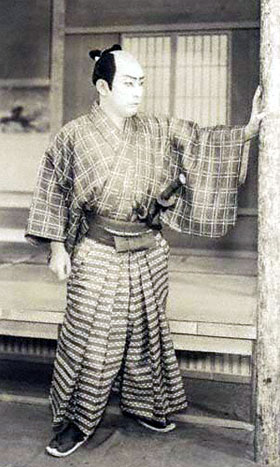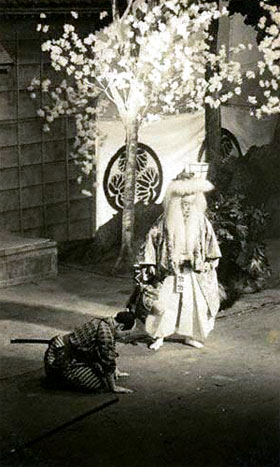| OHAMA GOTEN TSUNATOYO-KYď |
| Play title | Ohama Goten Tsunatoyo-ky˘ Genroku Chűshingura |
| Author | Mayama Seika |
| History |
"Ohama Goten Tsunatoyo-ky˘", the fifth play of Mayama Seika's cycle "Genroku Chűshingura", was premiered in January 1940 at the T˘ky˘ Gekij˘ [casting]. |
| Structure |
"Ohama Goten Tsunatoyo-ky˘" is made up of three acts, 5 scenes. |
| Key words |
Adauchi Adauchimono Ak˘ Ak˘ R˘shi Arai Hakuseki Arai Kageyu Asano Naganori Asano Takumi-no-Kami Chűshinguramono Daimy˘ Genroku Gishi Gishigeki Kira K˘zuke-no-Suke Kira Yoshihisa Rekishigeki Shinkabuki Tokugawa Ienobu Tokugawa Tsunatoyo Tominomori Masayori Tominomori Sukeemon |
| Introduction |
The ten play cycle of "Genroku Chűshingura" was written between 1934-1941, and is a retelling of the famous story of the forty-seven loyal ronin, although it differs considerably from the better-known Kabuki dramatisation of the tale, "Kanadehon Chűshingura", by greater historical accuracy (including using the real names of those involved), and by concentrating on the moral code underpinning the action. "Ohama Goten Tsunatoyo-ky˘" is the fifth play of the cycle. Previously, Lord Asano of Ak˘ has attacked and injured Lord Kira, as a result of which he has been ordered to commit seppuku. His loyal retainers have decided upon revenge, but a year has passed without any obvious action, and some now think that the vendetta has gone cold, particularly since ďishi Kuranosuke, Lord Asano's chief retainer, is living a life devoted to wine, women and song in Ky˘to. This is in fact a smokescreen for his real intentions. He has also, perhaps ill-advisedly, submitted a petition to the Sh˘gun requesting that the Ak˘ House be restored. This is still pending. In "Ohama Goten Tsunatoyo-ky˘" none of the principal characters involved in the vendetta appear, although the morality of the revenge is discussed, and the eponymous Lord Tsunatoyo (nephew and possible heir to the Sh˘gun) could have considerable influence regarding the outcome of Kuranosuke's petition. This introduction was written by Marion Hudson (2014). |
| Summary |
Act I: the Garden of Lord Tsunatoyo's Ohama Estate It is the day of the Ohama Asobi, or Girls' Festival, and all the female staff of Lord Tsunatoyo are enjoying a day off, with games and entertainments. The festival is traditionally an all-female affair, with no men allowed except for Lord Tsunatoyo and his invited guests - one of whom is to be Lord Kira. Urao, a senior lady-in-waiting, is pursuing Okiyo, a young lady in the household who is much favoured by Tsunatoyo. Okiyo has been seen receiving a letter from a young man, and, since serving ladies were forbidden to have love affairs, the spiteful Urao wants to see the letter, and threatens to take it by force, despite Okiyo's protestations that it was delivered by her (adopted) brother. Okiyo is rescued by Ejima, Lord Tsunatoyo's personal secretary, who orders Urao away on other duties. Okiyo explains to Ejima that the letter is from a senior lady-in-waiting at her former place of employment - Lord Asano's mansion. It says that Lord Asano's widow is seriously ill, but that her health might improve if the Sh˘gun grants the petition to reinstate the Ak˘ House, and thinks that perhaps Okiyo, as a favourite of Lord Tsunatoyo, could use her influence with him to gain his support for it. Lord Tsunatoyo's wife is also urging him to support the petition, and Ejima considers there is hence a good chance that he will do so. Tsunatoyo, however, is trying to avoid involvement in politics, and living a life of pleasure. He is the nephew and possible heir of the Sh˘gun, and does not wish ambition to be imputed to him in case it threatens his household. Okiyo's brother, Tominomori Sukeemon, who delivered the letter, has requested permission to watch the festivities through a gap in the hedge, and Ejima can see no reason why he should not do so, since this was a popular pastime amongst the local townsmen - although a less usual request from a Samurai. Lord Tsunatoyo enters, slightly the worse for drink, and trying to escape from his very formal wife. He learns of Sukeemon's request, which arouses his interest, as he remembers that he was one of Lord Asano's retainers and, suspecting that he must have an ulterior motive, readily accedes, although stipulating that he must remain outside the grounds. Okiyo has had no idea that her brother might be hoping to see Lord Kira, who will be taking part in the N˘ performance to be held in the evening. Kira is in fact hoping for Lord Tsunatoyo's help in improving his standing, since now even the Shogunate has turned against him in the face of public outrage. Tsunatoyo himself is in a dilemma, as he must shortly decide whether or not to support the petition requesting the restoration of Lord Asano's House, as his wife (and now also his favourite, Okiyo) wish him to do. He is hesitating since if the House is restored it will deprive the loyal retainers of any right to revenge, which, as a Samurai, Tsunatoyo instinctively feels is the honourable course of action; however, conversely such a restoration would extricate the Shogunate from the criticism heaped on it for its inept handling of the case. Consequently, he is keen to discover whether the ronin are still intending to go through with their vendetta or not, and thinks that a meeting with Sukeemon could be his opportunity to find out. Act II, scene 1: Lord Tsunatoyo's Study The famous Confucian scholar Arai Kageyu (a.k.a. Hakuseki) is awaiting Lord Tsunatoyo, having been summoned to advise him. Tsunatoyo confronts him with his dilemma over the petition. He asks if Kageyu considers that the Sh˘gun would approve it if he were to lend it his support? He has some reasons to suppose otherwise. Kageyu considers that, although the Sh˘gun thinks Tsunatoyo has given himself over to a life of dissipation and that consequently affairs of state should mean nothing to him, he feels that this opinion might be reversed were Tsunatoyo to support the restoration of the Ak˘ House. Tsunatoyo agrees - but still feels inclined to withhold his support since he would like to see a traditional revenge that would uphold righteousness. This would become impossible if the petition were granted - although not to support it would mean going against the wishes of his family and the likely wishes of the Imperial House. Once again, concern is expressed about Kuranosuke's apparent dissoluteness, although Tsunatoyo considers it may well be akin to his own, i.e. merely a ploy to mask other intentions. Throughout the scene Kageyu never offers any real advice, nor does he throw his weight behind one argument or another, but always encourages Tsunatoyo to draw his own conclusions - and then wholeheartedly agrees with him. Act II, scene 2: An Adjoining Corridor Tominomori Sukeemon is being escorted through the house, feeling very uncomfortable and protesting that he should not be there. He manages to elicit from his guard the information that Lord Kira will be arriving soon, and really wants to be somewhere where he can see him - as none of the ronin has ever set eyes on him, but need to be able to recognise him. It is only when Ejima appears to take him into her Lord's presence that Sukeemon realises that it is none other than Tsunatoyo who has summoned him. He tries unsuccessfully to escape. Act II, scene 3: Lord Tsunatoyo's Room Sukeemon is reluctantly dragged before Lord Tsunatoyo, refusing to get too close, and still making every effort to get away quickly. The astute Tsunatoyo runs rings around the hot-headed and obvious Sukeemon throughout the scene, showing many of the qualities that would make him an excellent future Sh˘gun. However, try as he might, he cannot induce Sukeemon to part with any information. He commences by casually remarking there is no need for Sukeemon to rush off just yet as the guest he is so anxious to set eyes on has not yet arrived. The off-guard Sukeemon starts - an action not missed by Tsunatoyo, who continues by heaping scorn on Kuranosuke's dissipation, and on the feeble loyal ronin for not having proceeded with their revenge, hoping thereby to provoke Sukeemon into a show of anger. Sukeemon rudely retorts that Tsunatoyo is like Kuranosuke, putting on a pleasure-loving front, in this case to conceal his ambitions on the Shogunate. Tsunatoyo continues by informing Sukeemon that Lord Kira is about to move from Edo to take refuge with the powerful Uesugi family, and after the implications of this have sunk in (i.e. that Kira would hence be out of reach of the vendetta), he plays his trump card, stating that he might speak to the Sh˘gun the very next day about the petition to restore the Asano household, which he says he intends to support. Sukeemon reacts desperately to this, begging him to reconsider, and thus giving Tsunatoyo his answer. The vendetta is still alive, and he knows which course he must take. He also guesses that Sukeemon will attempt to take Lord Kira's life that very day. But he still leaves casually mocking Sukeemon by reminding him that his attitude towards him has been somewhat impertinent. Okiyo remains with her brother, and when Lord Kira's arrival is announced outside, Sukeemon springs into action to attempt his murder. However, he is stopped by his sister, who does not want bloodshed inside the house. She suggests instead that her brother attack Lord Kira during the N˘ performance that evening, in which Kira is scheduled to take part, and promises Sukeemon her help. Act II, scene 4: Behind the N˘ Stage in the Grounds of Lord Tsunatoyo's Mansion Okiyo guides Sukeemon to the back of the N˘ stage, where he hides. Soon, a masked N˘ actor - apparently Lord Kira - appears, and Sukeemon attacks. But the actor proves a skilful fighter, who beats the would-be assassin, and then reveals himself to be none other than Lord Tsunatoyo himself who, guessing how Sukeemon would act, substituted himself for Lord Kira at the last minute. He berates Sukeemon, telling him that revenge without honour is no revenge at all, and explaining the moral implications of the vendetta to him. After revealing that he has no intention of supporting the petition, Lord Tsunatoyo has Sukeemon thrown out of the grounds, and then heads towards the N˘ stage to make his entrance with perfect composure. Summary written by Marion Hudson (2014). |
| Historical Note |
Lord Tsunatoyo was indeed adopted as the heir to the Sh˘gun, and in 1709 succeeded him, becoming the sixth Tokugawa Sh˘gun, Ienobu, although his rule was unfortunately very brief. The sympathetically portrayed Ejima continued in his service when he became Sh˘gun, and remained with the Shogunate after his death. Unfortunately, during the rule of his son Ietsugu (who succeeded his father at the tender age of four) she achieved considerable notoriety by having a scandalous affair with the handsome Kabuki actor Ikushima Shingor˘. This resulted in both being banished - to different places! - the unfortunate Ejima dying almost thirty years later, still in exile. This historical note was written by Marion Hudson (2014). |
 |
 |
|
Ichikawa Ennosuke II playing the role of Tominomori Sukeemon in the drama "Ohama Goten Tsunatoyo-ky˘", which was staged in January 1940 at the T˘ky˘ Gekij˘ |
Ichikawa Ennosuke II (bottom/left) and Ichikawa Sadanji II (top/right) playing the roles of Tominomori Sukeemon and Tokugawa Tsunatoyo in the drama "Ohama Goten Tsunatoyo-ky˘", which was staged in January 1940 at the T˘ky˘ Gekij˘ |
|
|
| Contact | Main | Top | Updates | Actors | Plays | Playwrights | Programs | Links | FAQ | Glossary | Chronology | Illustrations | Prints | Characters | Derivatives | Theaters | Coming soon | News |